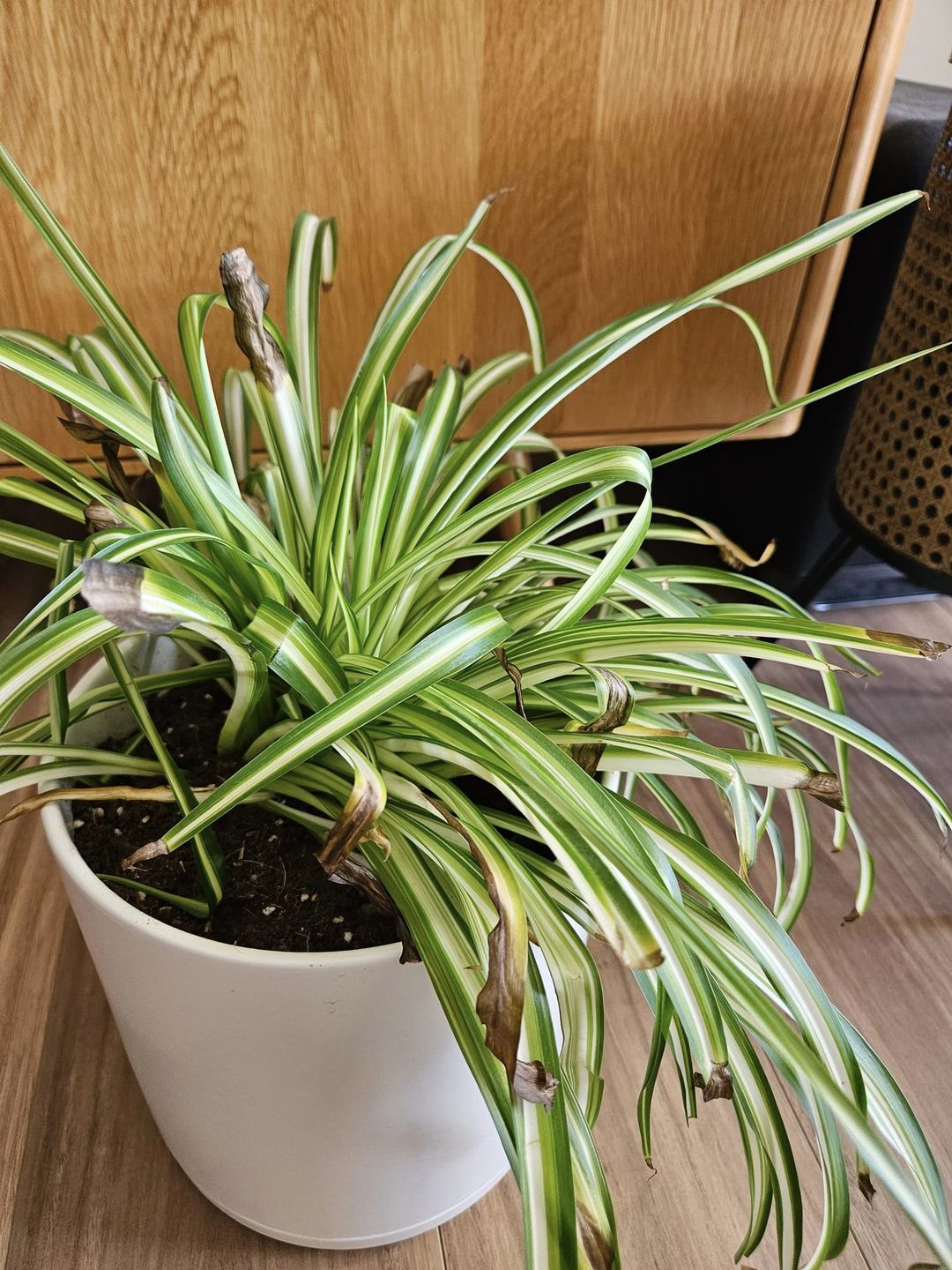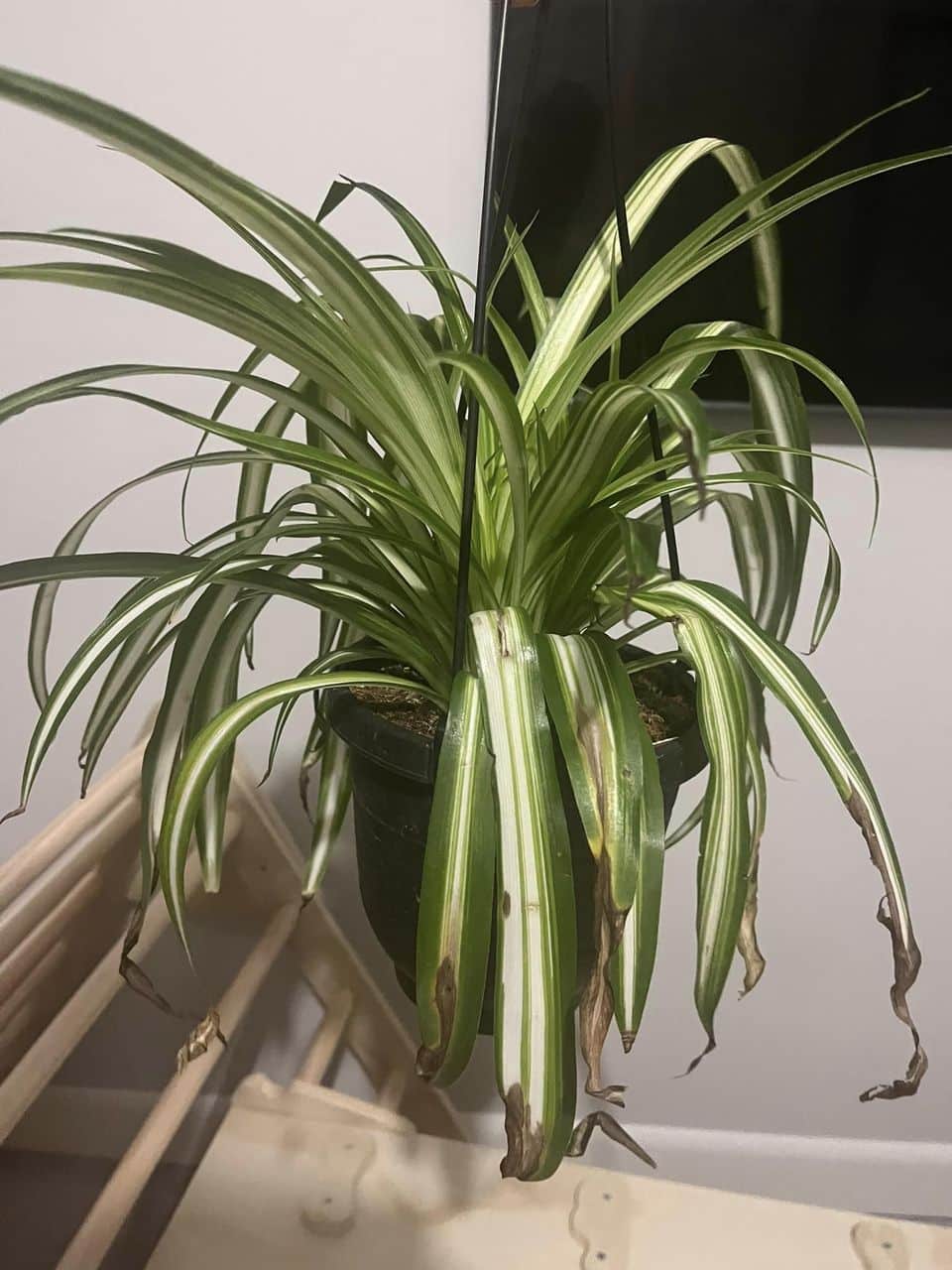Spider plants are hardy, resilient, low-maintenance plants that flourish with minimal care. These are but a few reasons this plant is a popular house plant. However, while spider plants are often considered low-maintenance, they still benefit from regular attention and care to thrive.
Sometimes, brown tips can adorn the once vibrant foliage of spider plants, leaving you puzzled and scrambling to uncover the cause and solution for this problem. Several reasons are responsible for turning spider plant tips brown.
Luckily, armed with knowledge, you can easily address this issue, thus restoring the vitality of your beloved spider plants.
Causes of Spider Plant Tips Turning Brown
Before we remedy this situation, let’s explore why spider plant tips turn brown.
1. Exposure to Excess Direct Sunlight
This is by far the most common cause for spider plant tips turning brown, meaning it should be the first thing to look at when you notice this problem. While spider plants love sunlight, excess direct sunlight is detrimental to their health.
Spider plants have delicate leaves that are sensitive to direct sunlight, especially when exceptionally hot. When exposed to intense sunlight for extended periods, the leaves can become sunburned, causing them to develop brown, crispy tips.
In addition to sunburn, excessive sunlight can also cause the plant to overheat. High temperatures plus direct sunlight can lead to dehydration and stress, further exacerbating leaf damage.
2. Overwatering
Giving your spider plants too much water can cause the tips to turn brown. The roots can rot if the soil is consistently wet, interfering with the plant’s ability to absorb nutrients and water. This can result in brown, mushy roots and eventually make the leaves brown and wilt.
Failure to fix root rot will eventually lead to plant death. Moreover, excess moisture can create a favorable environment for fungal diseases, which can damage the roots and interfere with nutrient uptake, leading to brown tips on the leaves.
3. Underwatering
The soil your spider plants grow in should be moderately moist for optimal growth. If you let the soil completely dry out before watering, your plants will get stressed, resulting in brown tips.
Stressed spider plants will prioritize water allocation to essential parts, such as the roots and central leaves. As a result, the outer leaves may show signs of distress, including browning of the tips.
Parched soil impairs the spider plants’ ability to take nutrients effectively, leading to deficiencies and brown tips.
4. Insufficient Humidity
The native home for spider plants is the subtropical and tropical areas synonymous with high humidity. For this reason, these plants prefer environments with moderate to high humidity.
Unfortunately, indoor environments, especially areas with dry air, such as heated homes during winter, do not usually provide these conditions as the humidity levels can drop, causing stress to the plant.
Like many other houseplants, spider plants lose moisture through transpiration. Transpiration rates increase in low humidity, leading to more rapid water loss from the leaves, causing dehydration and browning of the leaf tips.
Additionally, insufficient humidity can disrupt the balance of water uptake and loss, leading to uneven moisture distribution within the leaves. This imbalance can manifest as browning of the leaf tips due to localized dehydration.
5. Excess Fertilizer
Don’t be quick to apply fertilizers on spider plants with brown tips because excessive fertilizer could be the cause of the browning. For instance, too much fertilizer application can cause salt buildup. These salts can accumulate around the roots, interfering with their functioning.
High fertilizer salt concentrations can also directly damage the spider plants’ delicate root hairs, leading to root damage and impaired water uptake. This can cause dehydration and brown leaf tips.
Furthermore, excessive fertilizer can disrupt the soil’s nutrient balance, causing toxicities or deficiencies of certain elements. This imbalance can manifest as leaf tips and edges browning or yellowing.
6. Poor Water Quality
Do you use tap water on your spider plants? If yes, it could be why the plants have brown tips. Tap water usually has salts and minerals, which can accumulate in the soil. As these minerals build up, they can concentrate around the plant roots, leading to root damage and impaired water uptake.
Another way tap water can cause brown tips in spider plants is the presence of chemical contaminants like chlorine and chloramine. High concentrations of these contaminants can harm plants.
Also, water pH can affect the availability of nutrients in the soil. Excessively acidic or alkaline water can interfere with nutrient uptake and lead to deficiencies or toxicities, which could manifest as browning of the leaf tips.
7. Root Bound
The roots of your spider plants will eventually outgrow their containers, causing them to be tightly packed and unable to spread freely. Tightly packed roots have limited access to water and nutrients, which results in the plant not getting enough essential requirements for growth.
Root-bound also causes uneven water distribution to the leaves. Some plant parts may receive excess water, while others remain dry, leading to dehydration and brown tips on the leaves.
In addition, compact root systems restrict oxygen flow to the roots. Insufficient oxygen can cause the roots to suffocate and have diminished water and nutrient absorption capability.
Also, root-bound plants can produce more ethylene hormone that regulates growth. Elevated ethylene levels can trigger physiological changes, including leaf senescence and browning.
Severe cases of root bound can result in the roots encircling the root ball, leading to girdling and damage to the vascular tissues, disrupting water and nutrient flow.
8. Poor Quality Soil
Typically, low-quality soil lacks essential nutrients necessary for plant growth- brown tips can be a symptom of nutrient deficiency. It could also be dense or compacted, thus impeding root growth and limiting the plant’s ability to absorb water and nutrients.
Moreover, poor-quality soil may have an unfavorable pH level for spider plants. These plants prefer slightly acidic to neutral soil (pH 6.0-7.0), so highly acidic or alkaline soil can interfere with nutrient availability.
Additionally, some low-quality soils retain water excessively, leading to soggy conditions that promote root rot and fungal diseases. Also, the soil may contain contaminants such as heavy metals, pesticides, or pollutants, which can harm spider plants and cause leaf discoloration.
Related Posts:
- Why Are My Pothos Leaves Turning Yellow?
- How To Get Rid Of Fungus Gnats In Houseplants Naturally
- Why Do House Plants Get Brown Tips On Their Leaves?
Solutions For Brown Tips on Spider Plants
With the causes in mind, you can tailor the solutions for brown tips in your spider plants based on what caused it.
a) Adjust Your Watering Practices
Allow the soil to dry out slightly between waterings to ensure your spider plants receive enough water to grow properly and avoid making the soil soggy. You can also prevent waterlogging by using planters with holes for drainage.
Furthermore, adjust watering frequency based on environmental conditions such as temperature and humidity.
b) Environmental Management
Place your spider plants in spots with bright but indirect light and protect them from prolonged exposure to direct sunlight. Move them to a spot with filtered or indirect sunlight if they are exposed to too much light to prevent further leaf damage.
Ensure your spider plants are not exposed to cold drafts and keep the temperatures consistent to prevent stress. Moreover, periodically rotate the spider plant to ensure all sides receive equal exposure to light.
c) Humidity Control
Regularly mist the leaves of your spider plant or place the plant in a tray of water filled with pebbles beneath the pot to create a humid microclimate. Alternatively, using a room humidifier will also solve humidity issues.
Also, shield your spider plant from dry air sources, like drafty windows and heating vents.
d) Avoid Overfertilizing Your Spider Plant
Be mindful of how often and how much fertilizer you apply to your spider plant. Feed the spider plant with a water-soluble, balanced fertilizer once or twice a month throughout the growing season.
e) Transplant Your Spider Plant
Transfer your spider plant into a bigger container if it has outgrown its current pot. Ensure the new container is 1-2 inches bigger in diameter than the current pot and that it has sufficient drainage holes.
f) Pruning
If the roots are tightly packed and circling the root ball, carefully trim away the roots’ outer layer using sterilized scissors or pruning shears before repotting. Also, trim the brown tips using clean scissors to stimulate new growth and tweak the plant’s appearance.
g) Improve Soil Quality
Amend the soil with organic matter such as compost, peat moss, or aged manure to enhance its structure, fertility, and drainage, providing a more suitable growing medium for spider plants. Replenish the soil periodically with organic matter, monitor pH levels, and address nutrient deficiency or soil compaction.
h) Water Spider Plants with Clean, Balanced Water
Consider using filtered water on your spider plants to avoid mineral and salt buildup in the soil. If possible, collect rainwater to water your spider plant. If you intend to water your spider plants with tap water, leave the water in an open bucket for 24 hours first.
Conclusion
Understanding the causes behind brown tips on spider plants is vital because this issue is often indicative of underlying issues related to watering, environmental conditions, fertilization, or potting. This will help you implement appropriate remedies to fix the problem, ensure your spider plants thrive, and maintain their lush green foliage.

Hey there, fellow plant enthusiasts! I’m Rachel, the green-thumbed writer behind Rooted In Garden. With a deep-rooted love for all things botanical, I’ve made it my mission to help you cultivate a thriving collection of houseplants. As a devoted plant parent myself, I understand the joys and challenges that come with nurturing these leafy wonders. Whether you’re a succulent aficionado, an orchid enthusiast, or simply adore all potted flora, join me on this journey as we explore the secrets to growing and caring for our beloved green companions. Together, let’s create a flourishing oasis indoors.


